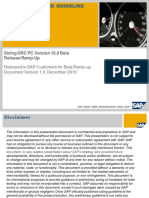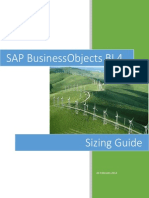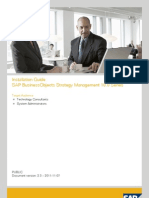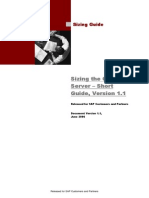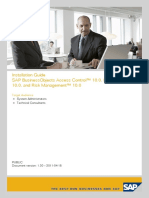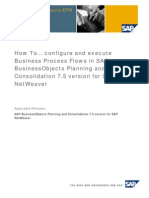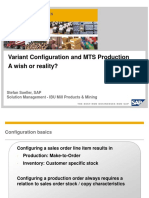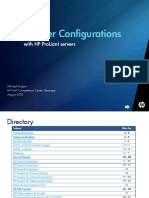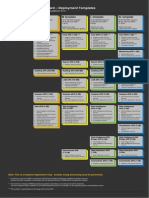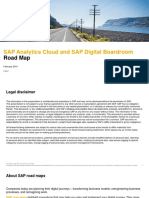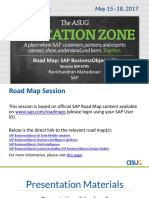0 ratings0% found this document useful (0 votes)
173 views76 pagesSAP BusinessObjects BI4 Sizing Guide
sizing
Uploaded by
Suresh MandalapuCopyright
© © All Rights Reserved
We take content rights seriously. If you suspect this is your content, claim it here.
Available Formats
Download as PDF or read online on Scribd
0 ratings0% found this document useful (0 votes)
173 views76 pagesSAP BusinessObjects BI4 Sizing Guide
sizing
Uploaded by
Suresh MandalapuCopyright
© © All Rights Reserved
We take content rights seriously. If you suspect this is your content, claim it here.
Available Formats
Download as PDF or read online on Scribd
You are on page 1/ 76
PLS
Contents
Who should use this document? ..
What You Need to KnoW.snnnnnninnnnnnnnnnttnennnnai 6
Get the Latest Version of this Document wninnnnnnntnnnnnnai 6
Pre-Sizing Checklist .s.ssnmnnnnnnnnnnsnannnnn nnnnnnnnnnnnnnnnnnnnnssnnnase 7
Post-Sizing Checklist. seve vn seen B
B14 Machine Requirements.
Introduction
Components and Platforms in Scope..
Disclaimer...
Co sen sen seen 10
Sizing T0OS nnn nnssnmnnnnnnnnnnnannnnn snnnnnnneseesessesnnnnne LL
Bid Resource Usage Estimator.
BI4.1 Configuration Wizard...
B14 Architecture
User Class Definitions wn.
Users, Active Users, Active Concurrent User$ wnnnns
Conceptual tiers and services. enn 1
Deployment and Sizing Methodology.
Sizing Steps and Methodology.
Processing and Memory Requirements Calculations
Prerequisites nics
Step 1: Resource Usage Estimator SetUB nnn
Step 2: Intelligence 08 Tier a sen one 18
Step 3: Intelligence Tier. 18
step 4: Application Tier... 18
Step 5: Processing Tier... 19
Analysis OLAP ssnssnn
Crystal Reports 2011
Crystal Reports for Enterprise...
Dashboard Design.
Web Intelligence
Lifecycle Management Service:
Platform Search Services,
Data Federation Service...
26
2 © SAP AG ~ Business Intelligence 4 Sizing Guide
Adaptive Connectivity Service son. snnenenernnnnns 26
Step 6: Sizing Analysis and Seale-out.. semnnancnnnenine 27
Step 7: APS Configuration 28
APS Service Groupings 28
Basic APS Configuration Instructions emu se se 28
Adaptive Job Server sou nnmnnnninnininninininnnininnnnninnnmnncnmminennnnanesnnnsnes 30
Step 8: Deployment and Monitoring .nisnmnnmninnininininninninnnninnnnnennmennnnenne BL
Scaling-out B14 Servers. a a semen 31
Building the System .... on
Monitoring Bld nn ses nnn seve 32
Using Audit Reports wun snnnnensennnnne 3S
Monitoring CPU and Memory Usage.
ssn sone 36
BI Tool Simulation Workflows.
Suggested Service Settings and Limits...
Central Management Service (CMS)..
Crystal Reports Cache Service nn
Dashboard Cache Service, Dashboard Processing Service...
Crystal Reports Processing Service
File Repository Service (FRS)...
Web Intelligence (Webl) Processing Service,
DSL Bridge Service.
Connection Server.. AL
Web Application Server
Scale-out Memory Expectations
Sizing Example.
Scheduling and Publishing...
for Performance
Scheduling and Publishing Best Practi
Use Dedicated Machines ...
YO sannnnisrsnnnnn ssinnnnnnnnsnnnnnnnnnnnannnnnnnansesnnnnne D2
Service Tuning ns serene ronnnne evn SB
Java Garbage Collection... 58
Setting an APS Garbage Collector .rsnnssnnn nnn seen SB
Setting the Tomcat Garbage Collector on Windows..nnsennnnmnnnnnnmannnnnnnsesnnnnnn SA
Setting the Tomeat Garbage Collector on UNIX and LIAUK win
3 © SAP AG ~ Business Intelligence 4 Sizing Guide
Minimum Memory Settings. snmnnennnnnnen SS
Web Intelligence Tuning... sone 56
Visualization Service .. 56
Web Application Server... 56
Crystal Reports for Enterprise Tuning snr nnn seen ST
Dashboards Tuning sn. nnnnnannnnnnnnnnnnnnn SS
Analysis OLAP Tuning. .nn
‘SAP BW Considerations and Recommendations... seen seems 61
BW Configuration. 81
Limiting Query Result Size. sn sn seve
BEx Query Performance sneneernesnnnnne
Navigational Attributes. ssn sons
BW Specific Tuning and Configuration
Set Specific Properties
Activate OLAP Cache and Delta Cache...
Additional Content suns sess ee)
CMS Database Tuning wnnnn
Virtualization: Service Level and Performance wn a nnn 65
Desktop Virtualization. 66
Sizing SAP BusinessObjects Live Office... 87
Sizing SAP BusinessObjects Explorer.. = 68
Sizing SAP BusinessObjects Mobile... 69
Sizing SAP BusinessObjects Design Studio nu se ene 68
Appendix... 70
Bid P&R Benchmark Testing Details. 70
Test report documents and data characteristics 70
Report data description... 73
CMS repository data description venues nnn evens
Test hardware specifications ...unmnnnninnnnnnnnnensnnnnnnannnnnnnninnnnnrsesnnnnns TA
Document Update History .unninniinnnnnnnneiinnninnnnannnnunnnninnnnssnnnnnnasssn 7S
4 © SAP AG ~ Business Intelligence 4 Sizing Guide
© Copyright 2023, 2014 SAP AG. All rights reserved,
[No part of this publication may be reproduced or
transmitted in any form or for any purpose without the
‘express permission of SAP AG. The information
contained herein may be changed without prior notice.
Some software products marketed by SAP AG and its
distributors contain proprietary software components of
ther software vendors.
Microsoft, Windows, Outlook, and PowerPoint are
registered trademarks of Microsoft Corporation,
18M, DB2, DB2 Universal Database, 05/2, Parallel
Sysplex, MVS/ESA, AIK, S/380, AS/400, 08/380,
(05/200, iSeries, pSeries, xSeries, zSeries, /05,
AFP Intelligent Miner, WebSphere, Netfinity, Twoll, and
Informix are trademarks or registered trademarks of IBM.
Corporation in the United States andjor other counties
Oracle isa ragistered trademark of Oracle Corporation.
UNIX, X/Open, OSF/1, and Motif are registered
trademarks of the Open Group,
Citi, ICA, Program Neighborhood, MetaFrame,
WinFrame, VideoFrame, and MuliWin are trademarks or
registered trademarks of Citrix Systems, Inc
HTML, XML, XHTML and W3C are trademarks or
registered trademarks of W3C*, World Wide Web
Consortium, Massachusetts Institute of Technology.
Java is a registered trademark of Sun Microsystems, Inc
JavaScrit is a registered trademark of Sun
Microsystems, Inc, used under license for technology
invented and implemented by Netscape.
MaxDB is a trademark of MySQL AB, Sweden.
SAP, R/3, mySAP, mySAP.com, xAPpS, xAPP, SAP
NetWeaver, SAP BusinessObjects and other SAP
products and services mentioned herein as well as their
These materials are subject to change without notice.
These matorials are provided by SAP AG and its affliated
companies ("SAP Group") for informational purposes only,
without representation or warranty of any kind, and SAP
Group shall not be lable for errors or omissions with respect
to the materials. The only warranties for SAP Group
products and services are those that are set forth in the
‘express warranty statements accompanying such products
and services, if any.
Nothing herein should be construed as constituting an
‘additional warranty
Disclaimer
Some components ofthis product are based on Java™.
[Any code change in these components may cause
unpredictable and severe malfunctions and is therefore
expressively prohibited, as is any decompilation of these
components.
SAP Library document classification: CUSTOMERS &
PARTNERS
Documentation in the SAP Service Marketplace
‘You can find this documentation at the folowing address:
bnto://service sap com/sizin
respective logos are trademarks or registered trademarks of
SAP AG in Germany and in several other countries all over
the world. ll ether product and service names mentioned
are the trademarks of their respective companies. Data
contained in this decument serves informational purposes
only National product specifications may vary.
5 © SAP AG ~ Business Intelligence 4 Sizing Guide ay
Who should use this document?
This document provides recommendations and best practices to help with deploying and scaling the
various services in SAP BusinessObjects Bl 4.
We recommend consulting this guide if you are
Working on a Sizing strategy, especially in conjunction with the Bid Resource Usage Estimator.
Be sure to use the most recent version of the Resource Usage Estimator.
«Planning to deploy SAP BusinessObjects BI 4 software
Optimizing or tuning an existing SAP BusinessObjects Bl 4 deployment
For all deployments, itis necessary to consult ¢ Sizing Expert in order to validate sizing exercises after
initial planning using the Resource Usage Estimator and this Sizing Guide.
Sometimes customers, partners, or consultants develop their own applications, strongly modify SAP's
out-of-the-box solutions, or implement complex integrations involving multiple systems. In these cases,
when sizing for the largest deployments or when your sizing requirements need to be extremely precise,
you should consider an “Expert Sizing”. An Expert Sizing is @ hands-on exercise performed by or in
collaboration with an SAP Professional, where customer-specific data is analyzed and used to achieve a
sizing result with greater precision. The main objective is to determine the resource consumption of
customized content, applications, and usage patterns by taking comprehensive measurements. For
more information, see htto://service.sap.com/sizing -> Sizing Guidelines -> General Sizing Procedures >
Expert Sizing,
What You Need to Know
To Size your deployment effectively and accurately, you need to know the following, which are
explained further in this document:
The SAPS rating of your hardware. This is the performance rating of the hardware you are going
to use for your deployment, You also need to determine the number of actual* cores in the
system and from that determine the SAPS-per-core value.
«Ifyou are using virtualized hardware, you need to know if the IT department will allow CPU and
memory reservations. Without reservations, the SAPS number will not be accurate and your
sizing calculations will be incorrect
+ The number of users of each 8! Tool that you intend to use. Within that context, the types of
each user (consumer, business user, expert). This is explained further in this document.
4 The relative document sizes for each BI Tool.
* The data sources the BI Tools will access
** "Actual’ cores refer to ‘full’ cores in a CPU. Hyger-threaded cores should not be counted for the
purposes of sizing,
Get the Latest Version of this Document
You can get the latest version of this document an www.sap.com/bisizing.
6 © SAP AG ~ Business Intelligence 4 Sizing Guide
Pre-Sizing Checklist
These are the things you need to do before you start your sizing exercise:
[How many Active Concurrent users will you have for each Bl tool? See “Users, Active Users,
Active Concurrent Users” in this document for more information.
[What types of users will be using each tool? Information Consumers (low workload), Business
Users (medium workload) or Experts (high workload)? See “User Class Definitions” in this document for
more information.
HZ Doyou know how users will use each BI tool? Will they refresh documents rapidly? Will they
schedule them at off-peak time? Will they open three documents at once? Will they build dashboards
that consume multiple reports? How users use the tools affects the workload they produce.
What types of machines will you be deploying to? What is the SAPS rating of each machine? See
“Bld Machine Requirements" in this document for more information.
What types of data sources will your users access? See “Data Sources” in this document for
more information.
EZ Will you be deploying to a virtualized environment? See “Virtualization: Service Level and
Performance” in this document and wws.sap.com/bivirtualization for more information.
Donat assume you are finished sizing if you only fill in the Resource Usage Estimator or the
Quicksizer. These tools do not cover all deployment scenarios nor all data sources. You must follow the
Deployment and Sizing Methodology section below to accurately size your deployment.
7 © SAP AG ~ Business Intelligence 4 Sizing Guide
Post-Sizing Checklist
Here are the things you should consider once you have followed the sizing steps in this guide:
HZ Doa sanity check on your deployment landscape. Are there too many I/O-intensive services
running on the same machine? Is it configured to allow for peak usage? L.e., do you think it will run
comfortably (around 65% average utilization) so that peak times don't cause issues?
Are the other parts of your IT infrastructure ready and sized for the load the Bl system will place
oon them? Has your BW system been resized and patched? Are the relational databases tuned and ready
for the load?
Check the BI Pattern Books for best practices in how to configure your deployment.
Check www.sapbusinessobjectsbi.com for the latest information on Bld, especi
area if that applies to you.
ly the Upgrade
To simulate user load, check out the Performance Testing SAP BusinessObjects BI Platform Web
site.
HZ —_Tolearn more about getting the most out of your infrastructure, see the resources available at
To ensure good performance in a virtualized environment, see “Virtualization: Service Level and
Performance” in this document and wwsv.sap.com/bivirtualization for more information.
Install auditing reports so you can monitor your system. A sot of auditing raports is available for
download at http://scn.sap.com/docs/DOC-6175,
Schedule a re-sizing in six months. See the Resizing section in this document for more
information.
8 © SAP AG ~ Business Intelligence 4 Sizing Guide
BI4 Machine Requirements
For Bi, the minimum hardware for evaluation purposes is 8000 SAPS of processing power and 16 GB of
memory. This is defined in the BI 4.1 PAM, found here: http:///scn.sap.com/docs/DOC-41355.
Hardware requirements for deployments of any kind are determined by following the remainder of this
guide.
Introduction
This document discusses the Sizing of the Business Intelligence 4 suite of services, hereafter referred to
a5 BI4, The Bid suite is designed to serve customers from small business to SAP's largest customers, The
umber of users, types of users, usage patterns, number of BI tools included in the suite, number of
data sources supported by the suite as well as the deployment options supported by the suite ll factor
into a series of variables that affect the successful deployment of the Bl suite. No configuration fits all
customers. The purpose of this document is to help guide you through the Sizing Exercise for BI4,
Sizing Bl is very different compared to sizing of other types of Enterprise software. Bl is a very resource
Intensive task. The act of extracting information from a potentially large amount of data requires
adequate amounts of processing power and exercises all the important subsystems of a computer: CPU,
memory, disk and network, Having the right amount of capacity of these four aspects of your system is
key to success. BI can also be very bursty, since the load can rely a lot on the schedule of its users.
ABI system is used much like Google is: searching for information interactively. If Google required 2
number of seconds to respond, most users would consider “the Internet broken”. They have an
expectation and often a business need to have a responsive system available to them. The purpose of,
this document is to help ensure your users can access BI decision-making information in a timely,
No tool or decumant can replace human judgment. So while this document attempts to cover as many
aspects of the Sizing Exercise as possible, Sizing Experts at SAP should always be consulted.
Make sure you have the latest version of this document and the other Bld Sizing resources by visiting
www.sap.com/bisizing
Components and Platforms in Scope
The guidance and estimates referenced in this document are based on the following:
© Analysis OLAP
© Crystal Reports 2011
+ Crystal Reports for Enterprise
* Dashboard Designer
+ Web intelligence
9 © SAP AG ~ Business Intelligence 4 Sizing Guide
General sizing tips are also provided for:
© Explorer
© Mobile 81
«Live Office
«B14 Platform services: Life Cycle Management, Search, Data Federation
«SAP BW
It is assumed that readers of this document are already familiar with core concepts from the Business
Intelligence Platform Administrator Guide (Admin Guide). There you can find conceptual information
and technical details on wide number of topics which are intentionally not covered in this guide.
Disclaimer
This document demonstrates how someone might perform sizing of a BI4 system. The methodology and
sample walkthroughs offered here are examples of the tasks and thinking involved. The performance
and functioning of an actual system may vary for many reasons. The examples offered here should not
be considered a guarantee of success of a particular deployment.
You should work with your SAP account representative and ensure you get the advice of a Sizing Expart
when making final decisions with regards to a deployment of Bi4.
Resizing
Its recommended that you resize your environment every six months or sooner if you have had
significant changes in the scope of your deployment. It can be difficult to anticipate how yaur users will
make use of the BI environment at the outset ofa project. Resizing is recommended to ensure your
systems are configured for how your users are using the system,
In order to be informed accurately about the usage of the system, it is recommended that you take
advantage of the auditing features end auditing reports available for BusinessObjects BI4. A set of
auditing reports is available for download at http://scn.sap.com/docs/DOC-6175 . These reports will
help you determine how your BI services are being use
Monitoring and probe reports are also recommended. Probe reports can give you alerts when time to
run expectations are longer than expected. See the BI4 Admin Guide for more information on creating
probes. CMS database performance should also be monitored.
Monitoring and recording of the basic CPU and memory usage of the machines in your deployment is.
also recommended. The goal is to have an average CPU usage of 60% to 65% in order to handle peaks in
the range of 80%. Analyzing the historical usage of your deployment can help you determine if more
resources are needed for a particular node. Similarly, if memory is frequently being fully used, you may
be experiencing reduced performance and need to add more.
10 © SAP AG ~ Business Intelligence 4 Sizing Guide
Sizing Tools
BI4 Resource Usage Estimator
The sizing tool reference in this document is the BI4 Resource Usage Estimator. It was previously named
the Bid Sizing Estimator. The estimates it provides are based on Performance and Reliability (P&R) sizing
benchmark tasts performed in SAP's test labs. The results and this tool help to estimate load based on
performance results in these lab tests. They are only estimates and should not be used as simple
predictions of performance or deployment guidance for your project. The Resource Usage Estimator is
just a tool. It and this guide must be used together to provide effective sizing guidance.
BI4.1 Configuration Wizard
Starting with SAP BusinessObjects 814.1, the Configuration Wizard helps the sizing exercise by defining a
number of APSes based on the deployment size chosen. This document explains how to perform a
custom sizing exercise, The Configuration Wizard's APSes can be used as a time saver when it comes,
time to define the APSes for your deployment. For more information, see the Bld.1. Admin Guide,
Br © SAP AG ~ Business Intelligence 4 Sizing Guide
BI 4 Architecture
‘The Bld architecture can be a complex set of services and technologies. The following is a representation
of the system from a technology perspective:
For the purposes of sizing Bld, the essential aspects of the BI4 architecture are this:
‘The Bid Platform: This is a set of base services that enable BI services to run in a distributed deployment.
Each node in a Bid cluster runs a Server Intelligence Agent (SIA) which runs selected services on that
node. Nodes in a cluster communicate over a service bus.
‘The Bid Platform and suite of services are designed using a 64-bit architecture to ensure scalability to
the largest customers.
‘The CMS: This is where all the objects and configuration information that control and secure the
platform are located. The CMS is a combination of service plus database for storing and retrieving this
information.
Basic Services: Core services such as the File Repository (FRS) need to run somewhere in the cluster.
APS: The Application Processing Service (APS) is a service host. 4 large number of the BI services run
inside APSes, There can be more than one APS running on a given node, and there can be many nodes
running APSes in a Bl landscape. Services running in the APS are Java-based and the APS controls the
JVM that the services run in, There is one JVM per APS.
R © SAP AG ~ Business Intelligence 4 Sizing Guide ay
Non-APS Services: Not all Bl services run inside an APS. Those that don't are run separately by the SIA.
BI Servcies: The Bl services in the system have specific architectural considerations:
Crystal Reports: Crystal Reports services are available in two versions: Crystal Reports for Enterprise is
designed to have great Universe and SAP connectivity. itis a newer version of Crystal Reports. It uses
data access technology common to the other tools in the suite.
Crystal Reports 2011 is the original Crystal Reports product line, maintained and available for backward
compatibility.
Web intelligence: Webl provides analysis and reporting capabilities to the suite. It provides compatibility
with old Universes (UNV), new Universes (UNX) as well as SAP BW. The Visualization Service (aka CVOM)
provides data visualizations (charting, graphics) services to Web and the DSL and DSL Bridge house the
data services for Webl.
User Class Definitions
Three user classes are defined below. Class definitions are used to identify how much the system will be
used and how much load will be placed on it. Information Consumers use the system a little and Expert
Users use the system a lot. Knowing the mix of user classes is important since it directly affects the
performance and resources required by the system.
Be aware that customers often underestimate the amount of use that a user will make of Bl system,
Information Consumers - The least active of all the user types. Information consumers spend an average
of 300 seconds (5 minutes) idle in between navigation steps. These users typically view predefined and
static content and perform relatively litte drilling and filtering on their own,
Business Users - These users perform some moderate amount of drilling and filtering on their own,
Business users spend an average of 30 seconds idle in between navigation steps.
Expert Users - The most active of all the user types. Expert users spend an average of 10 seconds idle in
between navigation steps. These users are much more likely to perform resource-intensive operations in
the system including ad-hoc analysis and customization of reports, retrieving a large number of rows,
and heavy client-side filtering.
Users, Active Users, Active Concurrent Users
Many sizing exercises begin with a total number of users, for example: the customer needs a system
sized for 10,000 users. The next step is to determine how many of those users will be logged-in to the
system at the same time. The bast way is to work with the customer to understand their usage
patterns. IF customer can’t provide guidance on this number, it’s common to estimate 10% as 2
minimum. We call these active users. In this example, there would be 1,000 active users. Because
users can spend much of thelr time being idle after logging-in, you also need to determine how many of
the active users in the systam will be concurrently generating load. This is another opportunity to take
customer usage patterns into account, but if there is no information available on this, the most common
3 © SAP AG ~ Business Intelligence 4 Sizing Guide ish
estimate is 10% as a minimum, We call these users who are logged-in and concurrently generating load,
active concurrent users. In our example, there would be 100 active concurrent users.
0 When you use the B14 sizing tools, specify your inputs in terms of Active Concurrent Users.
In the example above, we went from 10,000 users to 100 active concurrent users, which translate to 1%
concurrency. It's important to understand that the typical concurrency recommendations vary
depending on the size of deployment and other factors including the kind of work users perform.
If you expect or experience typical concurrency higher than these nominal ratios, you should expect a
heavier load and should compensate accordingly. For guidance in such a case, you may want to use the
Resource Usage Estimator and specify more users as ‘expert users’ to account for the increased use of
the system.
Conceptual tiers and services
The SAP Bi platform can be thought of as a set of conceptual tiers. A subset of each list of services is
provided here for convenience. Refer to the BI4 Admin Guide for the complete list.
Application Tier
© Web Application Service (typically Tomcat)
© CMC~Central Management Console
© Bilaunch pad
Intelligence Tier (Referred to in the Admin Guide as “Management Tier”)
«vse
+ Crystal Reports Cache Service
* Dashboard Cache Service
+ FRS
Processing Tier
+ Adaptive Job Service
+ Adaptive Processing Service (APS)
© Analysis OLAP and Multi-Dimensional Analysis Service (MDAS)
© DSL Bridge Service
© Visualization Service (VOM)
© Crystal Reports Processing Service
© Web Intelligence Processing Service
*1 The database which the OMS uses for its repository may sometimes be referred to as the “ineligence Tier DB"
14 © SAP AG ~ Business Intelligence 4 Sizing Guide
Deployment and Sizing Methodology
Sizing a BI4 deployment requires a reasonable degree of planning so that calculations and predictions
can be made about the needs of the system. The number of users and the needs of those users can be
used to predict load on the system. The types of data sources used have an effect on the load and needs
of the system. The needs of the users include the Bl services that they need to use. Some users use the
services a lt, some use them lt, Some reports are scheduled to be processed at night and viewed
during the day, Some reports need to be refreshed when viewed, which causes more load as the
number of users increases
Once the user requirements are defined, the system can be defined that will achieve the required
amount of processing. The final step in the sizing is to apply it to the hardware landscape. The
deployment hardware can range from many small machines to one large machine. The Sizing Exercise
includes the allocation of BI services to the nodes in the system, taking into account the CPU, memory,
disk and network capabilities of nodes to be used in the construction of the system landscape.
Sizing Steps and Methodology
The basic approach to sizing is working through the requirements of all the tiers in the deployment,
accounting for the processing and memory requirements of each subsystem. Most subsystems and
services have special considerations that need to be taken into account
Once the processing and memory requirements are determined, the next major step is to fit the services
to the hardware landscape. This requires knowing the SAPS per core rating of the computer to be used
as well as the amount of memory available to the machine or machines,
You must determine the SAPS rating of the machines that will make up your deployment. You
cannot assume any SAPS rating from this or any other document.
You can determine the SAPS rating of machines by visiting the Web site: SAP SD Standard Application
Benchmark Results
The Bid Resource Usage Estimator is used as a tool to help calculate the processing load to be handled
by each tier in your system. The Estimator is used to get initial numbers for processing and memory
needs. Depending on the BI tool under consideration, additional calculations may need to be made with
corresponding changes and/or additions to the sizing.
Processing and Memory Requirements Calculations
For each tier, especially the Processing Tier, the processing power and memory requirements need to be
determined. This is the core of the Siting Exercise. Once these numbers are determined, scale-out to
deployment hardware can be done.
The processing power is calculated and specified in a processing unit called SAPS. This is a processor and
computer independent unit that describes the processing power of a CPU in a given computer. SAPS is
an SAP-derived processing rating that allows you to calculate the power required by a deployment. it
a5 © SAP AG ~ Business Intelligence 4 Sizing Guide ish
takes into account the I/O processing capabilities of the computer in addition to its raw computation
abilities. Computers can have different SAPS processing capabilities even with the same type of CPU,
Prerequisites
The goal of the sizing exercise is to calculate the peak load that will be placed on the system. In order to
proceed with the sizing steps, you need to know the following information listed here. Gathering this
data accurately is the most important part of the sizing exercise since all the sizing calculations derive
from this information
Users: How many Information Consumers, Business Users and Expert Users of each type of BI tool. An
average user workflow is also important to know. If you expect users to open five BI documents and
refresh them all at the same time, that’s five times the load of one user. That needs to be accounted for
since the system needs to handle that load.
It is very important to know if the common workflow of the users is going to include refreshing reports
and if so, how frequently. Will the reports be scheduled to run at night and only be viewed during the
day or will they be refreshed by users avery hour? That's an important part of the load prediction and
thus the sizing estimate.
Data Sources: What types of data sources will be used: direct-access SOL databases, UNV Universes,
UNKX Universes, SAP BW, BW on HANA or HANA direct? It can be a mix. It’s important to know which
types of data sources will be used for the majority of Bl processing so that peak load can be predicted.
Some customers expect their mix of data sources to change over time, This is an important thing to
conside
Document Size: The relative size of each document is important to know. Will most documents be small
and cause little impact on the system or will most be large and require a lot of processing? This should
bbe determined for each Bl tool expected to be used.
SAPS Rating: In order to know how much computing resources are needed for a deployment, you need
to know the computer's performance rating. This is measured in SAPS, You may be building the system
Using one computer or many. You may have the computer(s) specified in advance or not until the initial
sizing has been calculated.
The SAPS rating of the system's intended hardware allows you to determine the required amount of
hardware to meet the system's processing requirements. The SAPS rating takes into account CPU
processing power as well as the computer's I/O capabilities. To learn the exact amount of SAPS
produced by your hardware, check the SAP SD Standard Application Benchmark Results Web site
For the sizing exercise, the amount of SAPS per core needs to be determined. The benchmark shows the
SAPS rating for the computer. You then need to divide by the number of actual cores of the CPU.
Note: Hyper-threaded cores should not be used for this calculation,
16 © SAP AG ~ Business Intelligence 4 Sizing Guide
Step 1: Resource Usage Estimator Setup
‘The Resource Usage Estimator should be initialized with the number of users of each type for each type
of BI tool. The report size sliders should also be set to reflect the sizes and types of documents that will
be processed by the system.
It might look like this:
ee ae oe En
ru (sars ia) Memory (6B (91) ]
TT —— Restore Systern Defaults
Set Configuration Template
Note: Analysis OLAP is also referred to as the ‘Multi Dimensional Analysis Service’ or MDAS.
See the Bl4 Admin Guide for more information on changing Analysis OLAP settings.
‘Din your sizing document, add in the SAPS and memory required for Analysis OLAP.
as © SAP AG ~ Business Intelligence 4 Sizing Guide
Crystal Reports 2011
To size Crystal Reports 2011, set the user numbers appropriately and set the user numbers for all other
tools to zero,
rocesna Ter SST eo TT
If your deployment will be to one large machine, you can record these requirements in your sizing
document and move to the next tool. Proceed here if you will be scaling out your deployment.
The Crystal Reports 2011 services required resources are determined by the processing requirements.
The required memory is calculated as follows:
Number of CPU cores x 1.25 GB/core
The number of cores is determined by the SAPS shown in the Resource Usage Estimator for the
Processing Tier (while having set only the Crystal Reports 2011 user numbers). To determine the
required CPU coras, divide the SAPS needed by your SAPS per core calculation (sae the Prerequisites
section above for more information). You should round up when you encounter fractional cores.
Once you know the number of cores needed, you can calculate the memory requirement by multiplying
by 1.25 GB per core.
‘Din your sizing document, add in the SAPS and memory for Crystal Reports 2011,
Crystal Reports for Enterprise
To size Crystal Reports for Enterprise, set the user numbers appropriately and set the user numbers for
all other tools to zero.
TT a
The Crystal Reports for Enterprise services required resources are determined by the processing
requirements.
The required memory is calculated as follows:
Number of CPU cores x 1.5 GB8/core
The number of cores is determined by the SAPS shown in the Resource Usage Estimator for the
Processing Tier (while having set only the Crystal Reports for Enterprise user numbers). To determine
the required CPU cores, divide the SAPS needed by your SAPS per core calculation (see the Prerequisites
section above for more information). You should round up when you encounter fractional cores.
20 © SAP AG ~ Business Intelligence 4 Sizing Guide
(Once you know the number of cores needed, you can calculate the memory requirement.
For example, 20 cores of processing power requires 20 * 1.5 = 30 GB of memory.
Din your sizing document, add in the SAPS and memory for Crystal Reports for Enterprise.
Data Sources
Crystal Reports for Enterprise is sized differently depending on the data sources expectad to be used.
Reporting directly on relational data sources or reporting on Universes requires no additional sizing.
When reporting on SAP BW including SAP BW on HANA, additional sizing is required,
BW Data Source Sizing
Querying report data delivered via BW requires additional processing and memory resources. Sizing is
done relative to the amount of data you expect to be retrieved by an average query and also by the
frequency of queries submitted to BW.
Note: itis very important to have a fully patched BW system and also for your BW system to be sized
and tuned to your Bl query needs. It is highly recommended that your BW system be checked and tuned
by a BW expert before connecting a BI system to it.
‘An example query is 100,000 rows with 10 fields, equivalent to 1 million cells. Your data set(s) may vary
in shape and size.
With a 2000 SAPS per core CPU, 1 million cells take approximately 10 seconds to process and require
11GB of memory for the processing. You need to judge the processing and memory requirements of your
queries accordingly, taking into account the SAPS per core rating of the computer. The processing time is
linear, so 500,000 cells should take about 5 seconds to process, for example. Similariy, if your CPU is
rated at 1000 SAPS, then 1 million cells will take about 20 seconds to process.
(Once you know the amount of processing to be done for each query, you need to determine how often
queries will be submitted. This can be new queries or report refreshes. The refresh frequency may be
quite low in the case of scheduled reports, or may be quite high if a sales team needs to refresh their
reports all at the same time of day. Itis important to get an accurate prediction of the peak load, since
under-rating this requirement can result in significant degradation of performance as the system
attempts to process multiple processing and memory-intensive operations at the same time.
21 © SAP AG ~ Business Intelligence 4 Sizing Guide
Divide the number of queries expected per minute by the time is takes to process a query to get the
number of cores needed to process BW queries.
60s per minute
jueries per core per minute =———S P&T ES _
v Pp Pp Single query process time (5)
required queries per minute
cores required = 4 TS PO
4 queries per core per minute
For example, to support 30 queries per minute where the query returns 1 million cells:
cores required Scores
To size the memory requirement, multiply the expected query size by 1000 and round up to the nearest
GB, This amount of memory will be needed for each core to process the BW queries.
For example, 1,000,000 cells per query x 1000 = approximately 1GB per core,
> In your sizing document, add in the SAPS and memory required for BW query processing.
JDBC Considerations
For medium to high usage Universe scenarios that make use of JDBC connectivity, including HANA JDBC
connectivity, additional memory should be allocated for the Java environment created by the
Connection Server, You should add 2GB of memory to the node that hosts the Connection Server and
change the configuration of the Connection Server to allocate that additional memory for the JVM. See
the Connection Server tuning section Connection Servar on page 41 for datails.
Dashboard Design
To size Dashboard Design, set the user numbers appropriately and set the user numbers for all other
tools to zero,
rece Tar SOREL recess er
Din your sizing document, add in the SAPS and memory for Dashboard Design.
22 © SAP AG ~ Business Intelligence 4 Sizing Guide
Web Intelligence
To size Web Intelligence, sat the user numbers appropriately and set the user numbers for all other
tools to zero,
Processing Ter 2 Prcesteg ier [TT
If less than 6GB of memory is shown, 6GB is recommended,
Din your sizing document, add in the SAPS and memory for the Webl Processing Server.
Data Visualization
The Data Visualization (CVOM) service is used by Webl. This service is recommended to have a memory
allocation of 268,
> In your sizing document, add in 268 of memory for the Visualization service.
DSL Bridge
The DSL Bridge service contains the data connectivity for UNX Universes as well as SAP BW. When Web!
uses either of these types of data sources, additional sizing for the DSL Bridge is necessary. See the two
following sections depending on the type of data sources that are expected to be used,
The DSL Bridge is an APS-hosted service.
Dota Sources
Web is sized differently depending on the data sources expected to be used. Reporting on UNV
Universes requires no additional sizing, When reporting on UNX Universes or SAP BW including SAP BW
on HANA, additional sizing is required. Apply sizing using the data source specific sections below as
appropriate.
UNX Universe Data Source Sizing
The sizing calculation for the DSL Bridge for UNX Universes is 0.25 GB per active concurrent user, 8GB
minimum, 30GB maximum.
If the calculation results in more than 30G8, additional DSL Bridge service instances should be created so
that no DSL Bridge instance has more than 30GB allocated to it.
> In your sizing document, add in the memory for the DSL Bridge service to handle UNX Universes.
Note: The processing power (SAPS) for UNX Universes is accounted for by the SAPS allocated to the
Web! Processing Server.
23 © SAP AG ~ Business Intelligence 4 Sizing Guide ish
BW Data Source Sizing
Querying report data delivered via BW requires additional processing and memory resources. Sizing is
done relative to the amount of data you expect to be retrieved by an average query and also by the
frequency of queries submitted to BW.
Note: itis very important to have a fully patched 8W system and also for your BW system to be sized
and tuned to your BI query needs. Itis highly recommended that your BW system be checked and tuned
by a BW expert before connecting a Bl system to it.
An example query is 100,000 rows with 10 fields, equivalent to 4 million cells. Your data set(s) may vary
in shape and size.
With @ 2000 SAPS per core CPU, 1 million cells take approximately 10 seconds to process and requires
1GB of memory for the processing. You need to judge the processing and memory requirements of your
queries accordingly, taking into account the SAPS per core rating of your computer. The processing time
is linear, so 500,000 cells should take about 5 seconds to process, for example. Similarly, if your CPU is
rated at 1000 SAPS, then 1 million cells will take about 20 seconds to process.
Once you know the amount of processing to be done for each query, you need to determine how often
queries will be submitted. This can be new queries or report refreshes. The refresh frequency may be
quite low in the case of scheduled reports, or may be quite high if a sales team needs to refresh their
reports all at the same time of day. Itis important to get an accurate prediction of the peak load, since
Uunder-rating this requirement can result insignificant degradation of performance as the system
attempts to process multiple processing and memory-intensive operations at the same time.
Divide the number of queries expected per minute by the time is takes to process a query to get the
number of cores needed to process BW queries.
60s per minute
jueries per core per minute = Per minute _
v Pe Pp ‘Single query process time (s)
required queries per minute
cores required =
queries per core per minute
For example, to support 30 queries per minute where the query returns 1 million cells
30 30
cores required = 735 =2?= 5 cores
To size the memory requirement, multiply the expected query size by 1000 and round up to the nearest
GB, This amount of memory will be needed for each core to process the BW queries.
For example, 1,000,000 cells per query x 1000 = approximately 1GB per core,
24 © SAP AG ~ Business Intelligence 4 Sizing Guide
The additional processing and memory is to be allocsted to the DSL Bridge service. In case the amount
of processing and/or memary exceeds the machine on which is runs, multiple DSL Bridge instances can
be created to-scale-out the load,
In your sizing document, add in the SAPS and memory for BWW query processing for the DSL Bridge.
When receiving and processing data from BW, the DSL Bridge requires memory te hold the query
results. This has the same memory requirement as UNX Universes: 0.25 GB per active concurrent user,
EGE minimum, 30GB maximum.
the calculation results in more than 3068, additional DSL Bridge service instances should be created so
that no DSL Bridge instance has more than 30GB allecated to it
In your siting document, add in the memacy for the DSL Bridge service to buffer the BW query
results
DBC, Consideration
For medium to high usage scenarios that make use of JOBC connectivity, including HANA JDBC
connectivity, additional memery should be allocated for the Java environment ereated by the
Connection Server: You should add 268 of memory to the node that hosts the Connection Server and
change the configuration of the Connection Server to allocate that additional memory for the VM. See
the Connection Server tuning section Connection Server on page 41 for details,
Lifecycle Management Services
‘Life Cycle Management! refers to the following group of services:
Visual Difference Service
* Lifecycle Management ClearCase Service
+ Lifecycle Management Service
* Trace Log Service
It is recommended that these services be grouped into a LCM-specific APS for medium and larger
deployments. For medium to large sized deployments, this APS should be allacated at least 750 MB of
memory. For very large deployments, this APS should be allocated at least 168 of memory.
For pracessing calculations, a nominal amaunt of SAPS of 1000 should be used.
Pin your sizing document, add in-the SAPS and memory for the LOM
Nate: For deployments prior to Bl 4.1$P3, onlyane instance of the LCM service should be run ina
cluster.
25 © SAP AG — Business Intelligence 4 Siting Guide =
Platform Search Services
Siting of the Search Service depends on your company’s intended ute of search, Itcan be turned aff,
used lightly or used heavily If you intend to use search, the amount of resources to allocate to it
depends on how much and how frequent content is changed in your system.
For a system where content doesn't change frequently during the day, you cen schedule search to index
at night.
It is recommended that a separate APS be created just far the Search Service. This will allow for easy
monitoring and configuration of resources for search.
For light usage of search, allocate 500 MB of memory and 1000 SAPS. For heavier use of search, allocate
3 GB of memory ang 3000 SAPS.
Din your sizing document, add in the SAS and memory for the Platfarm Search Service.
Data Federation Service
Ifyou intend ta use multi-seuree Universes, you needa size for the Dats Federation service.
It is recommended that an APS ba crested fer the purpase of running tha Date Federation, especially far
large deployments, This allows the data federation services to be monitored and configured easily,
For medium deployments, allocate 1 GB.of RAM. Fer larger deployments, allocate 2 GB of RAM,
Din your sizing document, add in the SARS and memory for the Data Federation service,
For more thoraugh siting of the Data Federation service, see the Date Federation Service Sizing end
Tuning Companion Guida, located on SAP Service Market Place (SMF)
Adaptive Connectivity Service
For medium and larger deployments, the Adaptive Connectivity service needs sizing. For medium
deployments, 500 MB of memory is recommended. For large deployments, 1 GB of memory is
recommended.
Itisrecommended that an APS be created for the purpase of running the Adaptive Connectivity services,
‘especially for large deployments. This allows the data federation services to be monitored and
configured easily.
‘Pin your sizing document, add in the SAPS and memory for the Adaptive Connectivity service ifneeded
26 © SAP AG — Business Intelligence 4 Siting Guide =
Step 6: Sizing Analysis and Scale-out
Scaling-out your deployment is often necessary, where the size of the deployment is larger than a single
machine that is expected te run the Bl system. Additionally, some analysis and thought is needed ta
selectively place services on nodes in a cluster so that optimal perfarmance and reliability is schieved.
‘Once you have the basic sizing as calculated in the above sections, you should have a list ofall the
services with SAPS and memory requirements for each. The next step is to ensure the hardware used in
nods of the deployment can handia the load
Befare assigning services to nodes in the system can occur, you need to determine what the constraints
of the system are. There wil vary likely be processing power and memory limits on each node. Some
nodes may be different,
For each of the tiers: Intelligence D8 tier, Intelligence tier and Application tier and for each
of the Bl tools to be used in your deplayment, do the following for each of the warkloads:
1. Start by assigning the warkload to anew node in the system,
2. Add in memory te account for the operating system and basic Gl infrastructure
components such as the SIA. 2GB) of memary and 2000 SAPS are recammended for
these functions.
3. Check to see if either of the processing power of the nade or the memory imit of the
nade has been excesdad for the workload that has been assigned to it. fit fits, you can
move onto the next workload, fit doasn’t fit, you need to add additional nodes until
the full processing power and/or memory forthe workload have been accommodated.
For workloads made up of APS-based servicas, an ABS specific to that workload should be crasted on the
node for those services, A nade may have ather services defined on it, possibly as a result of the
standard installation, Any services not intended for use an # node should be disabled. See the APS
Configuration section below for more information,
Incases whore more than ane workload can fit on a node, its fine to put multiala workloads on the
same node, However, be sure to teke inte account expected future growth and also mixing of similar
services. For exemple, Crystal Reports and Webl are bath very I/O intensive so they shouldn't be put on
the same node unless you don't expact them to be used at the same time, Similarly, the Application Tier
hosting the Web server can be bound by memory and processing power, which the DSL Brilge can also
be — these services shouldn't be put on the same node without some thought to the usage of the
system
"Mote than 26B of memory may be needed depending on the hardware platform and operating system used,
Consult your machine vender for more information.
a © SAP AG — Business Intelligence 4 Siting Guide =
Step 7: APS Configuration
The Adaptive Processing Server (APS) isthe aplication that hosts a let efthe Bl services, Multiple APSes
may be defined on multiple nodes within a deployment. In almost all cases mare than one APS will be
needed inthe system, both for management and maintenance of the running services. Often nodes in
the system need to run only a small subset of the available services inthe default APS created at install
time, making at least some amount of APS configuration necessary an every machine. Configuring APSes
is an escantial part of sizing Bld
ln BI 4.0, one APS is defined at installation, The rest of this section shows the basics of APS
configuration.
APS Service Groupings
When establishing your APSes, the following APS definitions are recommended
nsignt to Aceon Sennce je Imengence Montonng Service
"Web Intengence Wontonng Serve
er Pang Pay Se
ala Federalion Service
ene
‘Vsti erence Sec
TRGyoS Nernagrne CCE
Serves
Liecyee Managerneal Sanne
‘Mul Dimarsional Analysis Service
'BEK Web Application Serves
28 © SAP AG — Business Intelligence 4 Siting Guide =
Note: The color-caded groupings shown above can be used when deploying APSes for redundancy and
fall-over with minimal machine dependencies, The red group (right-hand column) services are related
‘the blue grcup (left-hand column) are mostly unrelated but have no dependencies on the red
group. In caces where you want to duplicate services and also reduce or eliminate machine
dependencies, this partitioning can be used.
Basic APS Configuration Instructions
It is strongly recommended that you not alter the original APS defined by the installer. If that APS is not
needed, it should be left intact, stopped and disabled.
How to Create a New APS
+ levthe CMC, go to the Services listing
«On the Manage menu, choose New and then New Server
Manage > Actors
SB3%\/co;>- me Be
BF serverstist Ts =
Gece [fe ee
eee © crystal Reports Services
Enocee © ata Feceration Services
WD service Cotman @_eenloner Services
RE ween
core: Properties Create Server Group |
= Se
1 =
On the Create New Server dislog box, choose the most appropriate Service Category
Select the first of potentially many services from the Select Service list, then press Next.
* Todd mare services to the APS, select them in the Available Additional Services list press >to
add them to the Selected Services list: Press Next wrhen done,
Give the APS a unique name.
Chose Create,
At this point the APS will exist but will net be enabled or started. You can enable and start your new APS:
by right-clicking on the new service in the CMC and selecting the appropriate options.
How to Permanently Disable an APS
29
* Inthe CMC, go to the Services listing
‘© Right-click on the server (APS) that you wish to modify
* Choose Disable Server
© Right-click on the server (APS) that you wish to modify
* Choose Properties
# Find the option: ‘Automatically start this server when the Server Intelligence Agent starts!
+ Unchack the eption,
© SAP AG ~ Business Intelligence 4 Sizing Guide a
Haw to Change the Memory Setting of an APS
Inthe CMC, go to the Services listing
Right-click en the server (APS) that yeu with to medify
Choose Properties
Locate the Command Line Parameters
Serollta the right until you locate -mnxlG (er similar it may have a different number
Change the number after the -Xmnx, For example to set the APS to use 6GB, change the
command line ta read -Kmx6G
Haw te Change the services running in an APS
© Inthe CMC, go to the Services listing
ight click on the server (APS) that you wish to modify
© Choose Select Services
See the 51d Admin Gi
depth information on configuring APSes.
Adaptive Job Server
Note that the Adaptive lob Server does not require “splitting” or configuration as described above for
the APS. This is because the Adaptive Job Server runs services as separate dedicated processes.
30 © SAP AG — Business Intelligence 4 Siting Guide a
Step 8: Deployment and Menitoring
[An important part of BI4 deployment is monitoring the operation of the various services tomake sure
they are running at a reasonable level of utilization, For BI systems, an average utilization goal Is 60% of
a node's resources. This goal is prescribed because of the bursty nature of BI, which doesn’t run in a
steady state but is very influenced by user workload.
During initial installation and testing, monitoring of the system is very important since the best sizing.
exercise can’t fully know hour a system will behave and perform. Simulating user load is highly
recommended, using products suen as Apache JMeter or HP LoadRunner, Start with a small number of
simulated users and bring the workload up slowly, watching how the system reacts. Proceeding
gradually will uncover any trouble spots that can be dealt with before progressing to a full warkload
Itis critical to menitorall aspects af resource usage in the systern:
= Disk
© Network
= CPU
© Memory
This neads to be done across the entire Bld landscape, including the CMS database and reporting
databases. The monitoring services in BIS provide a subset of the needed tools ta do this.
Depending an yeur monitor solution, you should enable the fellewing:
8, Proactively address
Scaling-out BH Servers
‘A very important aspect af sizing that is inferred by the seanarios above is the creation and deployment
of dedicated 814 servers, The goal ists have dedicated machines running just the services that are
necessary for its role. This is 8 common requirement of 2 scale-out deployment. See the Bid Admin
Guide for guidance on creating clustered deployments,
The Sizing Guide suggests that Bld be installed as a full installation on each server and then any
unnecessary services be turned off, This allows for a more simple installation procedure and also allows
for future changes to the deplayment. For exemple, if the role of a machine changes, all the B14
components are thera ta be enabled and disabled as necessary
Building the System
It is vary important to methodically “build out” the system.
18, Start with a smaller landscape, using smaller number of users te gain confidence in your
configuration. Gradually increase the load in increments af $0 to 200 users, only adding
services/servers as necessary.
b. Carefully monitor and analyze the performance and resource usage across the entire landscape,
including the CMS repository database, the Web application tier, and any other SAP BI 4
platform servers involved in the test to identify bottlenecks in either the underiving
infrastructure or server configuration
31 © SAP AG — Business Intelligence 4 Siting Guide a
¢. Take the appropriate actions to resolve problem areas at you find them. For example, adding.
another CMS hast if CMS CPU utilization is above 80%, Testing gradually and solving issues as,
they are found is important, since progressing immediately to a full workload can make
The CMS database is key to the overall performance and scalability af the Bl platform. A dedicated CMS
database running on dedicated hardware is always recommended. Work with your DBA to ensure the
CMS database server is correctly sized, configured, and monitored by referring to database vendor
materials on sizing.
The underlying infrastructure, including machines and network, is eritical to the overall performance ang
scalability of the BI platform; work with your infrastructure administraters to ensure the environment is
correctly sized, configured, and monitored
When starting your SAP Bid landecape, it's recommended to methodically start each of your server
intelligence agent (SIA) nodes and ensure all services are correctly started hefore starting anather node.
Monitoring 814
The Bid suite has a number of built-in monitoring capabilities that can be used to measure the
performance of the system as you build it up and continue into production,
Check the Processing Server Metrics
Itis recommended that you frequently check the Processing Server Metrics for the Bl processing
services that your deployment uses, especially in the setun phase of your project. Metries are
maintained for each processing service such as Average Processing Time, Maximum Processing Time and
Minimum Processing Time.
Here is an example for the Web Intelligence Processing Server:
Server tame state
GB _ MASTERSHAKE.AdaptvezobServer & running
|B _ MASTERSHAKE.AdaptiveProcessingServer & Running
G Ss
Properties
Start Server
Restart Server
Stop Server
Force Termination
Enable Server
Disable Server
2 © SAP AG — Business Intelligence 4 Siting Guide =
Some of the information shown includes:
Web Intelligence Processing Service Metrics
Cache size (Kb) 14764
umber of out-of-date documents in cache
Cache high mark count
(CPU usage (26)
Total CPU ume (seconds)
Memory high threshold count
Memory max threshold count
Virtual memory size (Mb) 2
Current number of citer calls °
Number of remote extension errors °
Current number of tasks °
Total number of client calls 0
Total number of tasks °
Idle time (seconds) 1869
Current number of active sessions °
umber of documents opened fram cache 0
umber of cocuments °
Current number of sessions ©
Number of document swap 0
Number of swapped documents 0
‘umber of sessions tmeout °
Total number of sessions °
Number of users 0
Mumber of active threads 0
Total number of threads 5
ES © SAP AG — Business Intelligence 4 Sizing Guide
Configure Report Processing Time Alerts
The Monitering festures of BI4 allow you te receive alerts when specific reports take too long to
process. Youcan configure probes that run a Web Intelligence or Crystal Reports document periadically.
You can be alerted if any of the documents take toa long to run,
Monitoring
Step 1: In the Monitoring area of the CMC, open the properties for the Crystal Reports Service
(Processing Server) to configure the probe for Crystal Reparts. Gpen Interactive Analysis to configure the
probe for Web Intelligence, You sheuld slready have documents ereated that you would like te maniter
the performance of, See the Bl Admin Guide fer more information on creating and configuring probes.
While the system isin testing and validation phases, report processing probes should be run frequently
[every few minutes) in order to effectively monitor the performance of the system.
(Once a system is placed inte production, it is suggested that you run report probes hourly so you ean be
alerted if system performance degrades
You can change the schedule far a repart prabe as shown here:
Schedule: Crystal Reports Service (Processing Server)
Fide Navigation
Properoes Recurrence
> Default Settings fun object: [Houry SSCS
~ Schedule ‘Object wil run every Whours and x minutes.
Instance Tile Hourtn) =[1 =] minute) = [0 =]
start oateTime: foa.=] [19] [Po] rtor201 3)
Schedule For
End Date/Time: [03 =] [19 =] [Pm =] [5/20/2023 &)
History
mite Number of retries allowed: (0
Retry interval in seconds: 1800
et © SAP AG — Business Intelligence 4 Siting Guide a
Step 2: In the Watchlist, create a new Watch that has rules based on the execution time of the probe.
Set the Caution to 5000 (milliseconds) to have a caution alert occur when the report takes longer than S
seconds, This is the most time a user expects # repart to require to process.
a
lar Admibtratoe | Pttsces ee | 0908
wa roy tw
oan
Set the Danger Rule to be seme larger amount of time, such as 19 seconds.
See the Bld Admin Guide for mare information, including information on creating CMS Database alerts,
The performance of the CMS is vital te the overall operation of the BusinessObjects environment and
setting probes to monitor its performance is recammended.
Using Audit Reports
Usage information for yaur Bld deployment can be ebtained by using audit reports. This can be wery
helping in determining hovr many users are using certain Bl tools, certain documents, ete, You can
download a.set of reports that are helpful for reporting on the BusinessObjects audit database here:
httei//sen.sap.com/dees/D06-6175
Es © SAP AG ~ Business Intelligence 4 Sizing Guide a
Monitoring CPU and Memory Usage
Monitering and recording of the basic CPU and memory usage of the machines in your deployment is
also recommended. The goal s to have an average CPU usage of 60% to 65% in order to handle peaks in
the range of 80%. Analyzing the historical usage of your deployment can help you determine if more
resources are needed far a particular nade, Similarly, if memory is frequently being fully used, you may
be experiencing reduced performance and need to add more
BI Too! Simulation Workflows
Creating simulated user workflows are very important in the testing of s:new deployment. The following
workflows are starting points for your user simulation. 8s sure your simulations make use of the
features that most users will use,
Crystal Reports
1. Logon to OpenDocument web application
2. View the repertin HTML viewer
3, Enter the Dynamic Cascading Parameters for live data and view first page
4, Gotathe 2nd page
5. Gotathe page in the middle of the report
Dashboards
1. Open Bl launch pad nage
2. Logon to Bi launch pad
3, Navigate te Document List Tab
4. Expand Public Folder
5. Opan the folder containing the Dashboard
8. View the Dashboard
7. Refresh the dashboard
8 Close the Dashboard
9. Logot
Web Intelligence
1. Open 8! launch pad page and login
2. Navigate to the folder that contains the Webl report
3. Openthe report
4. Open Advanced Prompt and Run Query for retrieve live data
5. Navigate to Sub Report, “Nation”
6, Start Drilling Mode, Drill Down, and End Drill
7. Close Document
8. Logoff
Analysis OLAP
9. Open BI launch pad page
20. Logen to BI launch pad
36 © SAP AG — Business Intelligence 4 Siting Guide =
Li, Navigate to Document List
42, Open Saved Workspace
13, Sap Axes
14, Print Analysis
35, Close Workspace
16. Logett
Suggested Service Settings and Limits
The following is a lit of specific services and associated configuration information and suggested best
practices.
Central Management Service (CMS)
The Central Management Server (CMS) can scale horizontally and vertically. The CMS provides server,
user, session management, and security (access rights and authentication) management.
A single CMS instance can service a large number active concurrent users, depending on the resources
of the machine on which an instance runs, 800 active concurrent users per instance is.a conservative
number useful far the purpases of planning yaur deployment. The recommended method for adding
OMS instances ta your deployment is to monitor the CPU and memory eansumation of each CMS
instance with a target goal of around 68% utilization. Adjust the number af ChSes while under
representative user load to achieve approximately 65% utilization. Too many CMSes can add
unnecessary synchronization traffic betureen instances. Toa feu CMSes will hinder performance of the
deployment.
Keep in mind that all CMS instances share the same repository datebese. If your repository DB vendor
doesn't offer low-latency horizontal scalability, you'll need to ensure you follow your 0B vendor's
guidance an howto size and scale vertically, expecislly far deployment with thousands of active
concurrent users.
** The performance of the CMS database is very important to the overall performance of the system, It
is strongly recommended that your CMS database be sized and tuned fer high performance aperation by
‘a qualified DBA, See the section, CMS Database Tuning CMS Database Tuning, for more information.
Crystal Reports Cache Service
The Crystal Reports Cache Service scales both up end out and can support 400 active concurrent users
per instance, You will very likely not need more than 1 instance on any given machine, since the Cache
Service is never enough of a bottleneck to make this necessary.
Because of the volume and frequency of communication betwaenthe Processing Service and the Cache
Service, t's recammended that you deploy in pairs, That is, on each machine where there is a Cache
Service, also deploy a Processing service and vice versa. This can yield better performance than having
the Cache Service and Pracessing Service on different machines.
37 © SAP AG — Business Intelligence 4 Siting Guide =
Dashboard Cache Service, Dashboard Processing Service
Because the technology used for the Crystal Reports and Dashboard Cache and Processing Services are
largely the same, the scalability characteristics and recommendations are also the same. Refer to the
Crystal Reports Cache Service and Crystal Reports Processing Service and use the same information for
Dashboards,
Required memory is calculated as follows:
# of children = # of logical cores +2
Each child may use up to 1.5 GB of RAM
Crystal Reports Processing Service
When sizing for workflows involving a small number of users viewing Crystsl Reports, you may notice
high values for recommended memory. You may also notice that for a larger number af users the
requirad memory is almost constant (it does not increase much when more users are added). This is the
expected behavior and itis due to the internal functionality of the Crystal Reports processing servers
and engine, which are optimized to offer smoother overall performance, especially for s higher number
of users over a longer period of time. Theaptimal allocated memory is Based an an algorithm that uses
the number of CPUs on the machine rather than the number of users in the system, Because of this, it's
not recommended to have more than one Crystal Reparts Processing Service on any given machine. As
you scale-out your deployment, it's batter to add instances to other machines that dan’t current have
Required mamery is caleulsted as follow
Crystal Reports 2011
# of children = # of logical cores "2.5
Each child can use upto 500 MB of RAM.
> 1.25 GB percore
Crystal Reports for Enterprise:
# of children = # of logical sores +2
Each child can use upto 3 G3 of RAM
> 15GB per core
Because of the volume and frequency of communication between the Processing Service and the Cache
Service, it's recommended that you deploy in pairs. That is,an each machine where there is @
Processing Service, also deploy a Cache Service and vice versa.
Data from the database is written to disk in the temporary directory during processing. The speed of
‘this-disk will have an effect on precessing performance,
Note: Each Crystal Reports child process (as noted above) can procass a number of report processing,
jobs at once. A job can potentially be shared among multiple user requests depending on sharing
criteria, Crystal Reports 2011 child processes default to 40 jabs each while Crystal Reparts for Enterprise
child processes default to 20 jobs each. The number of jabs par child determines how many child
processes are crested. The number of users served by 2 child process can be greater than the job limit if
38 © SAP AG — Business Intelligence 4 Siting Guide =
job sharing is possible. Sharing can occur when a job's report processing criteria match, such as data
security and parameter prompts. It is the role of the cache server to control job sharing,
File Repository Service (FRS)
While your deployment can have multiple Input and Qutput FRS instances, the first FRS pair i
output] to register with the CMS become the only active FRS pair, Other FRS instances are.considered
passive backups. Although all FRS instances run simultaneously, only the active FRS pair handles
requests. Ifan active FRS fails, a passive FRS is changed to active status. When the previously active FRS
becomes operational again, its registered as a passive FRS with the CMS,
Good disk and I/0 performance is ritical for the operation of the FRS
‘Web inteligence (Webl) Processing Service
You can scale the Web Intelligence Processing Service up or eut. For every 200 active concurrent users,
ivis suggested you create a Webl Processing Service instance. This amount is suggested given the I/O
processing that Webl usually requiras, You can adjust the number of active concurrent users allowed
per server by adjusting the Maximum Connections setting,
In-order to ensure the load on Webl serversis spread evenly among multiple instances, ensure the sum
of all Maximum Connections settings is greater than or equal to the number of active concurrent users
expected. For example, iFyou had 400 active concurrent users and twa Webl Processing Service
instances, each should be set to at least 200 for Maximum Connections, for a total of 400.
When adding additional Web! instances, it is recommended that each instance run on a separate
maching in order to maximize the I/O capacity aveilable to the servers. If you need to accommodate
more users ona single machine and it has the I/O capabilities, processing and memory to handle more
Users, you can just increase the Maximum Connections setting {in addition to increasing the memory
allocation),
39 © SAP AG — Business Intelligence 4 Siting Guide =
The following shows how the Maximum Connections setting is configured.
Web Inteligence Core Service
Use Configuration Template
Timeout Before Recycing (seconds):
Idle Document Timeaut (seconds):
Server Poling Interval (seconds):
Maximum Documents per User:
Maximum Dacuments Before Recycling:
FF Allow Document Map Maximum Size Errars
Ile Connection Timeout (minutes):
FF Enable Memory Analysis
Memory Lowee Threshold (MB):
Memory Upper Threshold (Ma):
Memory Mascmum Threshold (MB):
FF enable APS Service Monitoring
When tuning your Webl server instances, be sure te review all the cattings shawn here to besure they
make sense for your intended usage. For example, if you intend to scale Webl up to take advantage of a
very capable machine but don’t adjust the Memory Maximum Threshold setting to match, you may find
the Webl service recycles itself unnecessarily. See the Bl4 Admin Guide for more details on each of these
settings,
Data Source Considerations
When sizing Webl, it is important to consider the date source(s) being used. Ifyou are using UNX
Universe or SAP BW data sources, the DSL Bridge service is employed Ry Webl, which hosts the data
connectivity. See the
40 © SAP AG ~ Business Intelligence 4 Sizing Guide a
Web Intelligence section above ragarding sizing of the DSL Bridge in addition to the next section.
DSL Bridge Service
The DSL Bridge service is used by Webl when it connects to SAP BW and UNX-format Universes, It hosts
the data connectivity to these data sources.
Memory is calculated based on the number of expected active concurrent users as follows:
* 0.25 GB peractive concurrent user
© 868 minimum
© 2063 maximum
The recommended maximum number of active concurrent users per DSL Bridge service is therefore 120.
H you require support for more active concurrent users, yau can create additional DSL Bridge service
instances,
You can create DSL Bridge service instances with smaller maximum heap sizes if that suite your
landscape better.
Connection Server
For data connectivity scenarios that use the Connectian Server (commanly Webl and Crystal Reports),
the recommended database connectivity is ODBC or native middleware, where available.
For Java-based {JD8C) middleware, including JDBC drivers for HANA, additions performance
configuration may be required for the Java Virtual Machine (JVM) that is created by the Connection
Server that hosts the JDBC driver. For larger user loads, the default VM memory settings may be
inadequate, The memory allocated te the JVM created by the Connection Server can be increased by
editing the esc file, located in ...instelidic/sap_bobi/enterprise_xiQ0/dateAccess/connectionServer on
Unicand Linux and here on Windows: C:\Program Files (x86)\SAP BusinessObjects\SAP BusinessObjects
Enterprise XI 4.O\dateAccess\connectionServer.
Sot the “Kms and =Xmx settings as shown below. Here they ara being set to 168 at startup and 268
maximum mamery usage.
€l-- The default JVM configuration can be overriden here
¢Libraryhame INIVersion
-->
soptéens>
* en ssn
INI_VERSION_4_4" »ABSOLUTE_PATH/Sve.dL1/sap_bobj/tomeat /bin/setenv. sh
Invthat file, change the JAVA_OPTS parameter to include -4X:+UseParallelOldGc. tt will lack similarto
this:
Minimum Memory Settings
For Java-based processes such as the APS-based servers in a deployment, setting a nominal minimum
memary setting aids Java in its management of memory. The default for Java process such as the APS is
32M, which is wary small. For most APSes, the minimum suggestion is $12 MB, depending on the
expected load of the system.
How te Change the Initlal (minimum) Memory Setting of an APS
# Inthe CMC, go to the Services listing
Right-click on the server (APS)
* Choose Properties
# Locate the Command Line Parameters
© Scroll tothe right until you locate -Xms parameter, if present,
* Change or add the parameter, setting the number after the -ms w
h ne space, For example to
set the APS to start with $12. MB, set the command line te read -Xms512M
) SAP AG — Business Intelligence 4 Sizing Guide
Web Intelligence Tuning
DSt Bridge
You should ensure there are one or more dedicated APS instances running only the DSL Bridge Service,
The recommended heap size is 0.25 GB per active concurrent user, 868 minimum, 30 GB maximum.
More DSL Bridge service instances can be created if necessary to suppert the number of active
concurrent users required.
Maximum Connections
Under heavy load, the Webl Processing Server can benefit fram having @ maximum connection setting
that is higher than the maximum number of expected concurrent connections. This is because under
heavy load, the time te close a connection can increase and Web| may not be ready to accept the next
connection in time. See the section Web Intelligence (Webi) Processing Service Web Intelligence (Wel)
Processing Service for mare information on setting the maximum connections.
Multiple Processing Instances
It isnot recommendad that yau run multiple Weal Processing Server instances on the same machine,
The two services can degrade the perfermance of each other as they make heavy use of I/O bandwidth,
etc. If you wish to run more than ane server instance, they should be run on separate machines.
SAP BW
If you are using SAP BW, the recommended DSL Bridge Service paramaters are:
+ BICSResultGhunkSize < of rows of the biggest rowset> / 50
+ BICSLOVChunkSize <# of items of the biggest LOV> / 20
Thase are both registry settings that are set differently on Windows and UNIX.
(On Windewe: Go to [HKEY_LOCAL MACHINE\SOFTWARE\SAP BusinessObjecte\Suite X1
4.0\default\Webintelligence\Calculator] and create the above as DWORDs (decimal)
(On UNIX: Go te INSTALL_BASE_DIR/sap_bobj/data/.bobi/resistry/64/softwrare/sap
businessobjects/suite xi d.0/detault/webintelligence/calculator and add two keys using parameter
names as above to the .registry file.
Visualization Service
The Visualization Service (CVO) generates graphics and charts for Webl. This service should run in one
or more dedicated APS instances. 26B of memory is recommended for this service.
Web Application Server
For deployments that involve sizable numbers of users, mobile users or remote users, itis
recommenced that the Web tier be split to deliver static content by a separate Web application server,
Static content (HTML pages, images, documents, JavaScript and Cascading Style Sheets) - content that
doesn’t change—can be delivered by a Web server dedicated to that tack. The Apache Web server is:
typically used for this
56 © SAP AG — Business Intelligence 4 Siting Guide =
You can learn more-about splitting the Web tier by consulting the Web Agolication Deployment Guide
found on htto://nele.sep.com, Additional help en doing a split Web tier can be found in the SAP
Community Network document, “Improving the User Experience in SAP Bl Platform 4.0 with Apache and
WDeploy.” An update to this document is available that covers SAP BI 4.1 and the latest version of
Apache httpd, version 2.4, You can find that documant here: http://sen.sap.com/docs/DOC-50325
‘A simplified guide has been created that walks you through the steps of the Apache Split for Windows
deployments: Quick Stea-t je to Ag lit Deployment with BIS,
Te learn mare about deplaying multiple instances of Tameat, see the SAP Business Intelligence Platform
Pattern Books,
Crystal Reports for Enterprise Tuning
Controlling Job Creation
To ensure the number of job processing child pracesses created by the Crystal Reports Processing
Service doesn’t exceed your needs, itis recommended that you configure the Maximum Concurrent Jobs
entry to match the number of users you expect to support. Open the Properties of the
CrystalReportsPracessingServer and locate the Crystal Reports Processing Service section 3s shown here:
Crystal Reports Processing Serie
Use Configuratian Template
DLL Name:
Temporary Directory: ‘SeDotaultDtaDiry CrystalReportsP
Manamum Concurrent Jobs (0 for automatic): °
Maximum number of Pre-started Chidren: i ~«Y
Ile Connection Timeout (minutes): 20
Tle 3ob Timeout (minutes): 20
FF Share Report Data Between Chents
Viewer Refresh Always Yields Current Oata
(Oldest On-Demand Data Given ta Clients (seconds): (g
Java Class Path: ‘S¢CommondavalibDir94/ proc jar
Java Child VM Arguments: (Dousinassabjects.connectuty. direct
TT Restore System Oefauits
[Set Configuration Template
87 © SAP AG ~ Business Intelligence 4 Sizing Guide a
Increasing Memory Allocation for Improved Response Time
Depending on your reporting needs and the design of your reports, it may be possible to imorove the
processing time of reports by allocating more memory for Crystal Reports to work with. This is done by
increasing the amount of memory allocated to each Crystal Reports child process. You may want to do
this in the case where you have extra processing and memery headroom on s machine beyond your
‘essential siting requirements. Allowing Crystal Reports to more quickly process reports has obvious
responsiveness benefits and also allows the system to be better abla to handle spikes in demand.
Each Crystal Reports processing child process has a defautt memory allocation of approximately 268.
You can increase this by setting the Java memory parameter in the Java Child VM Argumentlist, as
shown below in the settings for the CrystalReportsProcessingServer in the CMC, In this example, the
memary is changed to.8GB by specifying 8192 MB using the parameter setting Xmx81920.
Frapertios node Crystakeportt rac Sereer 7
Tide eaten
=
ae Use Confira Vera
Hace Nees
ang Server croup) | Temporary Braco: ‘isfauiuatial yeaah
annum Concur be (0 for autora: a
aur lene beach
Maxroum Wariber of Presa Chien: 1
be Coremton Harm Grten)= =
Ba Tet (ma) a
\& StareRegor ata Between Cents
1 nt Raton sy Yk Cet ats
(lies or-bemar Data Go Chere (secs)
Cas Path
en Oa egies:
fesore Sytem befits
set coneurason Terai.
You may want to increase the number of concurrant jobs if your goal is to increase the number af
reports that each child process can deliver. As showin here, the number of cancurrent jobs has been set
1080.
58 © SAP AG — Business Intelligence 4 Siting Guide a
Dashboards Tuning
To ensure the number of job processing child processes created by the Dashboards Processing Service
doesn't exceed your needs, tis recommended that you configure the Maximum Concurrent sobs entry
to match the number of users that you expect to support.
Dashboards Processing Sendce
7 Use Configuration Template
Manammurn Concurrant sobs (0 for automate): |g
Maximum Lifetime 2obs Per Child: 10000
Mazimurn Number of Prestarted Children: L
dle Connection Timeout (minutes): 15
|e Job Timeout (minutes): 15
Java Child vet Arguments: ‘xrsS6M, Dswlinjecton.lang,drect
7 Restore system Defaults
Set Configuration Template
59 © SAP AG ~ Business Intelligence 4 Sizing Guide a
Analysis OLAP Tuning
[Analysis OLAP (MultisDimensional Analysis Service or MDAS) works the best when run in its own APS.
‘See the section Step 7: APS Configuration, “Step 7: APS Configuration”,
Memory
(Once in its own APS, it is recommended that MDAS be configured with a minimum of 4GB of memory,
The section Step 7: APS Configuration outlines the steps for configuring the memory settings af an APS,
Sessions
The MDAS "Maximum Client Session” setting is often set to 8 low number by default. It is recommended
that it be set in a range of 45 to 100 depending on the expected load.
Each MDAS can support up to 100 client sessions. Te support more sessions, create additional APS
instances that hast an MDAS service. It is recommended that additional MOAS APSes be deployed on
separate machines,
Muli Qimensional analysss Service
Use Configuration Template
OF cells returned by a query: 100000
Maximum number of members natured when filtering: “roo000
T Restore System Defaults
TO Set Configuration Template
60 © SAP AG ~ Business Intelligence 4 Sizing Guide a
SAP BW Considerations and Recommendations
When using BIS to report on SAP BW data, the following recommendations are made to ensure the best
performance possible:
BW Configuration
‘+ Apply the latest fies available from SAP by applying the latest suppert packs to your BWW system
‘+ Itis strongly suggested thet your BW be sized for the anticipated query load expected fram the
81d system.
* Have @ BW expert tune the system generally and BEx queries specifically for your Bld usage
Limiting Query Result Size
Consider the BW Safety Belt feature, which helps to ensure report developers don't create reports with
result sets that are larger than desired. The Safety Belt faaturs is described here:
https://sen.sap.cam/does/D0C-31900
BEx Query Performance
Check the performance of BEx queries. See the SAP nate: BiLCuery Runtime Statistics which is found on
the SAP Support Web site at
httes/Jhelp.sap.com/saphelo_nw70/helpdata/EN/43/e29fd25 #50278 10000000815 5247/frat
htm
You can determina how much time the execution of certain user actions requira in the front-end and in
the SAP BW analytic engine.
Navigational Attributes
A large number of navigational attributes defined in the underlying InfoPravider may impact the overall
performance (please refer to SAP best practices for data modeling). This can lead the Bid tools to
generate lot of "Crossjoin" operators, causing extra unused data to be returned in qui
BExqueries to be sure they include only the infarmation necessary for Bl.
ies, Revisit your
Characteristic attributes can be converted into navigational attributes. They can be selected in the query
inexactly the same way as the characteristics for an InfoCube. In this case, 2 new edge/dimension is
added to the InfoGube. During the data selection for the query, the data manager connects the
InfoProvider and the master data table join’) in arder to fill the Query.
From @ pure performance point of view, yau shauld model an abject on a characteristic rather than ona
navigational attribute.
6 © SAP AG — Business Intelligence 4 Siting Guide =
8W Specific Tuning and Configuration
‘Set Specific Properties
'* Check the option: Use Selection of Structure Elements
‘+ Choose the Read Mode option: Query to Read When You Navigate or Expand
Chacking the Read Made property helpsimprave performance in situations where there are many
Restricted Key Figures and other calculations in the Query Definition.
analysis of the query performance indicates very high EVENTID 3200 times and/or the FEMS number is
very high, try enabling this property and check performance.
Checking the Use Selection of Structure Elements option ensures the structure elements are sent to the
database for processing
You can see these settings shown below:
‘Query Monitor
(Qesccue [Oeste Debug B] Genera Repo | [[EPrpetes [OBmessaces [Grice roxs [SFeenermonton |
|Hirerormance im [[ETeceicaliromnaton |Ecaens Nornor [SEcueyvarants [108 Test [Roetvaracn [Scomata vant |
[Bhscar vee [Ebsarawven |
use oS TPS
auey tear i B] rarer O Peremer2
ead Mode | neyo Fd man You Haig EEA Tinto
Faq Status [GAIPeaPrniders Uo Ralevted Chava PROT intvPr
Cache Made {Nain Mero Cache Pict Swapsing _|E h/uPnier Seting
TUdate ache Geiecs Delia Process (2rvoProier Sting
(lee Season af Sacre are
oowtetsteweracind Murer
(Dropmate orcessing
(Cloceneratonog
Optintaton Mose [Diaueer Wt Be Oririaed ar Oaneraion
Distasi bey Figures input Ready
Disagarepenon an Tatas | Daa a
Seatetc et [Terror EnaiCaewlaton Layer ata]
a © SAP AG ~ Business Intelligence 4 Sizing Guide a
‘Activate OLAP Cache and Delta Cache
Anew cache mode is delivered with Support Package 16 for 817.0 and currently, the new OLAP cache in
B2P is not active yet (SPL7 for BI7.0 is implemented in 82P), The Delta cache, which is expecially
important to uncompressed InfoCubes, is not in use for some queries at this moment. This means that
the OLAP has te fetch the data from database again ence new requests are sent to InfoCubes, while
delta cache is not enabled. This can result in an increase of OLAP time as well as Database time and
‘eventually the entire query runtime. It is recommended to activate the new OLAP Cache mode by
running the report SAP_RSADMIN_MAINTAIN and setting "Update cache objects in delta process".
Additional Content
More BW performance tuning information can be found here:
© Performance Ootimizing SAP BusinessObjects Reports Based Upon SAP BW Using BICS Connectivity
http://wurw.sdn.sap.com /iri/scn/g0/ portal/prtroot/docs/library/uuid/d0s3c552-e4.19-3010-1788-
b3226210058d?overridelayout=trus
© Business Intelligence Performance Tuning
https://inws_sdn.sap com iri/sdn/bicperformancectunin
© Performance & Scalability Best Practices and Tuning Recommendations for SAPBO XI 3.1 on BW.
hitp://werwscn.sap.com/iri/scn/go/ portal/prtroot/ docs/library/uuid/005b1374-8F91-2d10-Fe9c-
#Bfa1 25259570 uickLink=indexBoverridelayout=true 4874787963301 1
cy © SAP AG ~ Business Intelligence 4 Sizing Guide =
CMS Database Tuning
The CMS database performance has a significant impact on the performance of the system, The
following Sybase database tuning tips are offered. These tips may apply to other database servers as
1
64
Data Cache [buffer pool]
Data cache sllows efficiently reducing IO. Having a sufficient size of data cache can speed up
queries.
Procedure Cache
Configure the Procedure Cache so frequently used database procedures are cached. This allows
the database to not need to reload procedures from disk as often.
Lock Granularity
The CMS does:a lot of reading and writing from/to the database. 8y default, the granularity is
st to page level, which is toc high. Page level lacking promotes contention by the CMS when,
for example, several records are stored together in a same page. One of them may be being
updated but another one is being read. One of these twa sessions has then te wait until other
has finished.
Setting Lock Granularity te use row level locking can aveid contention and deadlork issues,
Parallel Processing:
This is important te set so Sybase can fully utilize all the CPU cores available on the machine,
© SAP AG ~ Business Intelligence 4 Sizing Guide =
Virtualization: Service Level and Performance
B14 Works very well in virtualized environments, Testing has shown it performs equally well on
virtualized hardware as it does on dedicated hardware. However, in order to achieve equal
performance, the hardware it runs on must be dedicated to the virtual machines that the BI services run
SAP strongly recommends that Bl virtual machines have reservations far the memory and
CPUs assigned to them.
Bl is a bursty application workload. it can be very 1/0 intensive when heavily loaded by users. When
‘experiencing maximum load as defined by your sizing, all parts of the system can go from moderately
loaded to very busy momentarily. Fthe BI hardware is being shared with other workloads in a
virtualized environment, the response to bursts in activity can result in slow-downs between dependent:
Bl services and ultimately and user response time.
It is recommended that you build your system to target 65% utilization so that bursts in activity can be
handled. Performance of both physical and virtual systems degrades when system utilization is ereater
than 80%,
Hf you are unable to secure memory and CPU reservations for your virtualized deployment, itis
recommended that additional scale-aut be done to provide adequate Bl processing resources for peak
periods. The amount of additional scaling out will depend on your IT infrastructure and performance
policies.
The goal af Sizing Bid is to have a deployment that can hendle the workload needed and provide good
response time for end users. If you deploy to a shared virtualized environment, extra cares needed to
ensure your
be maintained.
resultsin a system which has a Service Level and responsiveness that can
For more in-depth information on | and Virtualization, see the SAP Bld Virtualization site at
mb
alization
6 © SAP AG — Business Intelligence 4 Siting Guide =
Desktop Virtualization
When running BI4 desktop applications sre deployed to virtualized desktop environments such as Citrix
‘and Windouss Server Remote Desktop Services, sizing is required to determine how many concurrent
users can be supported far commenly used Bl applieatians,
The following table shows the memory footprint of applications that you may run in a virtualized
desktop environment. You can use the memory footprint infarmation to calculate the amount of
memory required to service the number of users required.
“Product =——SS~*~<~*~s*~
You might also like
- SAP BusinessObjects BI4 Sizing Guide PDFNo ratings yetSAP BusinessObjects BI4 Sizing Guide PDF76 pages
- Determine Your Sizing Requirements With Quick SizerNo ratings yetDetermine Your Sizing Requirements With Quick Sizer5 pages
- Business Solutions by IBM and SAP: Send Completed Questionnaire To Either Your Local IBM Contact orNo ratings yetBusiness Solutions by IBM and SAP: Send Completed Questionnaire To Either Your Local IBM Contact or24 pages
- SAP Solution Manager 7.0 As of SP15: Sizing GuideNo ratings yetSAP Solution Manager 7.0 As of SP15: Sizing Guide19 pages
- Principles of SAP HANA Sizing - On Premise and CloudNo ratings yetPrinciples of SAP HANA Sizing - On Premise and Cloud47 pages
- GRC - PC - 10 0 - PreliminarySizingGuideline - V5No ratings yetGRC - PC - 10 0 - PreliminarySizingGuideline - V516 pages
- Installation Guide Sap Businessobjects Access Control™ 10.0, Process Control™ 10.0, and Risk Management™ 10.0No ratings yetInstallation Guide Sap Businessobjects Access Control™ 10.0, Process Control™ 10.0, and Risk Management™ 10.052 pages
- Installation Guide SAP Enhancement Package Installation100% (1)Installation Guide SAP Enhancement Package Installation88 pages
- 3609 Variant Configuration and Make-To-Stock Production - A Wish or RealityNo ratings yet3609 Variant Configuration and Make-To-Stock Production - A Wish or Reality16 pages
- Upgrade Guide SAP Enhancement Package 4 For SAP ERP 6.0 ABAPNo ratings yetUpgrade Guide SAP Enhancement Package 4 For SAP ERP 6.0 ABAP144 pages
- Business Intelligence 4 Adaptive Server ProcessingNo ratings yetBusiness Intelligence 4 Adaptive Server Processing6 pages
- Unit 1: Vision and Customer Value: Implementing SAP S/4HANA Cloud With SAP Central Business ConfigurationNo ratings yetUnit 1: Vision and Customer Value: Implementing SAP S/4HANA Cloud With SAP Central Business Configuration8 pages
- SAPS - SAP Sizing Benchmark Https WWW - Sap.com About BenchmarkNo ratings yetSAPS - SAP Sizing Benchmark Https WWW - Sap.com About Benchmark4 pages
- SAP Analytics Cloud and SAP Digital BoardroomNo ratings yetSAP Analytics Cloud and SAP Digital Boardroom21 pages
- How To Report On Cross Company Stock in Transit PDFNo ratings yetHow To Report On Cross Company Stock in Transit PDF30 pages
- SAP Yard Logistics SAP Yard Logistics SAP Yard Logistics SAP Yard LogisticsNo ratings yetSAP Yard Logistics SAP Yard Logistics SAP Yard Logistics SAP Yard Logistics1 page
- Connecting To SAP BW With Microsoft Excel 2007 PivotTables and ODBONo ratings yetConnecting To SAP BW With Microsoft Excel 2007 PivotTables and ODBO28 pages
- Connecting To SAP BW With Microsoft Excel 2007 PivotTables and ODBONo ratings yetConnecting To SAP BW With Microsoft Excel 2007 PivotTables and ODBO28 pages














